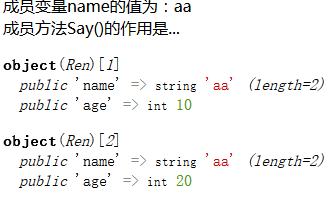2016/3/22 面向过程 面向对象:①多态 ②引入页面加载类
面向过程:每一步骤,步步推进,重复使用性差。
面向对象:封装(class类,function方法,new初始化),重复使用性强。
例子:
1 //面向过程 2 $r1=20; 3 $r2=10; 4 $mj=3.14*$r1*$r1-3.14*$r2*$r2; 5 echo $mj; 6 7 //面向对象 8 class yuan 9 { 10 private $r; 11 function __construct($r) 12 { 13 $this->r=$r; 14 } 15 function mj() 16 { 17 return 3.14*$this->r*$this->r; 18 } 19 } 20 $yuan1=new yuan(10); 21 $yuan2=new yuan(20); 22 echo $yuan2->mj()-$yuan1->mj();
①多态:父类引用指向子类实例,由于子类的不同,所表现出的差别,就是多态。
注意:
1,Java中多态的实现方式:接口实现,继承父类进行方法重写,同一个类中进行方法重载。
2,子类继承父类方法是重写。类不同。
3,同一类中类型不同,数量不同,是方法的重载。
例:
1 class Ren 2 { 3 public $name; 4 public $age=10; 5 6 public function Say() 7 { 8 9 echo $this->name."正在说"; 10 } 11 function __construct($n) 12 { 13 $this->name=$n; 14 } 15 function __tostring() 16 { 17 return "成员变量name的值为:".$this->name."<br>"."成员方法Say()的作用是..."; 18 } 19 function __clone() //克隆的方法 20 { 21 $this->age=20;//$this找的是复本 22 //$that->aa=16;//$that找的是原本,老版本中有,新版本中已弃用。 23 } 24 25 26 } 27 $ren=new Ren("aa"); 28 $r2=clone $ren; //克隆 $ren
29 echo $r2;
30 var_dump($ren);
31 var_dump($r2);
显示效果:

继承中的重写:
1 class Ren 2 { 3 public $name; 4 public $age=10; 5 6 public function Say() 7 { 8 9 echo $this->name."正在说"; 10 } 11 function __construct($n) 12 { 13 $this->name=$n; 14 } 15 function __tostring() 16 { 17 return "成员变量name的值为:".$this->name."<br>"."成员方法Say()的作用是..."; 18 } 19 function __clone() 20 { 21 $this->age=20;//$this找的是复本 22 $that->aa=16;//$that找的是原本,老版本中有,新版本中已弃用。 23 } 24 25 26 } 27 28 class China extends Ren 29 { 30 public function Say() 31 { 32 echo "你好!"; 33 } 34 } 35 $ren=new China("hello"); 36 $ren->Say(); 37 echo $ren->name;
显示效果:

② 引入
方式:
相对路径:从当前文件找到另一个文件路径。
include("文件名.php");//同级目录下
include"../文件名.php"; //上级目录
require_once("文件名.php");//同级目录下
require_once"文件夹名/class.php";//下级目录
自动加载类
1 function __autoload($classname) 2 { 3 require_once"class_".$classname.".php"; 4 }
例子:
1 include("text6.php"); 2 $test=new Text(); 3 var_dump($test); 4 $test->run();


显示效果:



